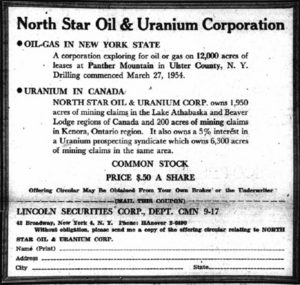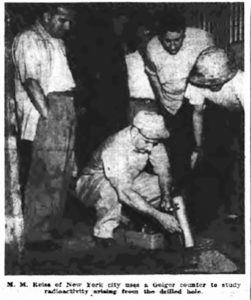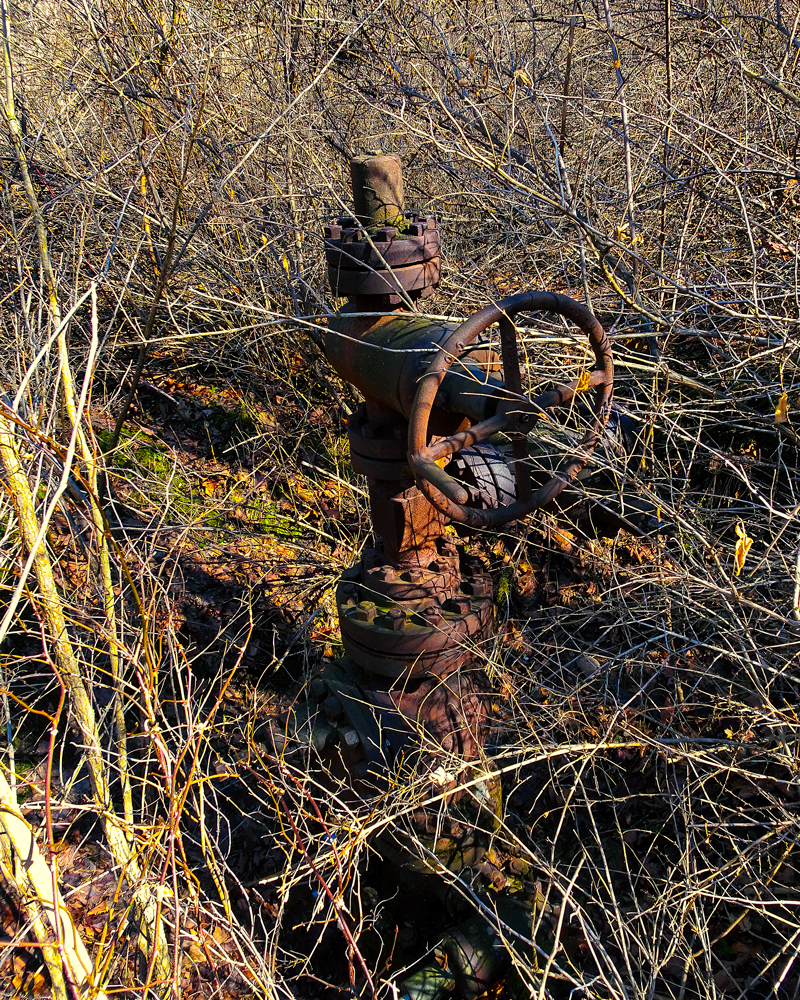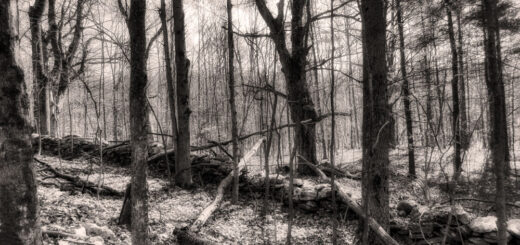The Forgotten Gas Well of Fox Hollow
It happened on a February night in 1955, in the heart of the Catskill Mountains. A large group of locals had gathered in Fox Hollow in the town of Shandaken. They stood in a semi-circle around the spot where—over the course of the past year—hardworking men from elsewhere had drilled a hole into the bedrock over a mile deep. Word had spread that a major strike of natural gas was imminent. Even so, repeated maintenance to the rig was causing delays. Dull drill bits had to be pulled up from the hole and swapped out. The shivering crowd grew impatient. Many of them were investors in the project.
To entertain the restless, shivering throng that surrounded him, the project engineer occasionally wadded up a handful of paper, set it ablaze with his cigarette lighter, and tossed it down the hole, in the hope that a spot of gas might be ignited. If so, the hole would erupt in spectacular fashion, flames shooting to a height of six feet or more above the casing. In those instances, the astonished faces of the onlookers would glow in a ghastly extrusion of light, reminiscent—if I might be so bold as to make the comparison—of the scene depicted in John Quidor’s 1832 painting “The Money Diggers.” More often than not, the engineer’s awkward attempts at pyrotechnic diversion failed. His blazing wads of paper simply disappeared from sight, snuffed out in the dark bowels of the Devonian earth. The crowd, as often happens when epic failure occurs in full public view, would fall silent—followed by a nervous laugh here, the stamping of cold feet there, and a palpable sense of unease throughout—until the noisy business of pounding into the earth resumed and hope was restored to its proper elevation in the hearts of those who harbor big dreams.
 The lofty expectations brought to Fox Hollow on that frigid February night in 1955 had been building for decades. Numerous homeowners reported finding natural gas percolating up through the water in their shallow wells. One local paper reported that a “vent in the well of Mr. and Mrs. Simon Berger has kept a lamp burning for many years.” In the 1930s, a group of farmers from Phoenicia banded together with a prominent state geologist to promote the idea of commercial drilling for natural gas in the Catskills. Financiers showed little interest in the scheme, until the early 1950s, when all of a sudden everybody seemed to have a plan as to how transform the Catskills into the next Texas—or better than Texas, because Shandaken was so much closer to the gas markets in New York City.
The lofty expectations brought to Fox Hollow on that frigid February night in 1955 had been building for decades. Numerous homeowners reported finding natural gas percolating up through the water in their shallow wells. One local paper reported that a “vent in the well of Mr. and Mrs. Simon Berger has kept a lamp burning for many years.” In the 1930s, a group of farmers from Phoenicia banded together with a prominent state geologist to promote the idea of commercial drilling for natural gas in the Catskills. Financiers showed little interest in the scheme, until the early 1950s, when all of a sudden everybody seemed to have a plan as to how transform the Catskills into the next Texas—or better than Texas, because Shandaken was so much closer to the gas markets in New York City.
The biggest money seemed to be behind an outfit called Dome Gas & Oil Corporation, a “wholly owned subsidiary of North Star Oil and Uranium Corp., with offices at 295 Madison Avenue, New York City.” According to records, both entities were formed in 1953. They wasted no time in issuing stock and buying up drilling leases from property owners throughout the counties of Ulster, Greene, and Delaware—over 12,000 acres in total, mostly in Shandaken. It was a risky venture to be sure, as no profitable gas wells had ever been opened in this part of the state. As the project engineer explained to a group of stockholders in an April 1954 meeting: “There’s no guarantee, but every study so far, by honest men who know their business, leads us to believe that the possibilities are good. If we do find a commercial supply of gas, it’ll be a humdinger.”
Dome Gas & Oil commenced its drilling operations in Fox Hollow on March 27, 1954. Eleven months later, they were poised on the verge of great success, having struck a sizeable quantity of gas soon after that February night of great expectations. This discovery was enough to quintuple the price of the company’s initial stock offering of 50 cents per share. The quantity of gas being produced by the well, however, proved insufficient to be commercially viable. The stock began a slow and irreversible descent.
 By the end of 1955, Dome Gas & Oil had suspended its drilling at Fox Hollow. A well head was installed on the hole and operations were moved to a second site—over in Rider Hollow, some miles to the west in Delaware County. A year later, the new well had been sunk to a depth of 3800 feet, but it too proved unviable. On March 8, 1957, the headline in the local paper read: “Gas Wells: Nearly Forgotten Business.” The article reported that Dome Gas & Oil had shuttered its offices in Manhattan and relocated to a small town near Utica. The attention of its “principal promoters” had been “diverted to a large-scale uranium hunt in Orange County.” And that is the last—at least at this point—that history has to say about Dome Gas & Oil Corporation and its ambitions to bring a gas boom to the Land of Rip Van Winkle.
By the end of 1955, Dome Gas & Oil had suspended its drilling at Fox Hollow. A well head was installed on the hole and operations were moved to a second site—over in Rider Hollow, some miles to the west in Delaware County. A year later, the new well had been sunk to a depth of 3800 feet, but it too proved unviable. On March 8, 1957, the headline in the local paper read: “Gas Wells: Nearly Forgotten Business.” The article reported that Dome Gas & Oil had shuttered its offices in Manhattan and relocated to a small town near Utica. The attention of its “principal promoters” had been “diverted to a large-scale uranium hunt in Orange County.” And that is the last—at least at this point—that history has to say about Dome Gas & Oil Corporation and its ambitions to bring a gas boom to the Land of Rip Van Winkle.
Upon the cessation of drilling activities in Fox Hollow, the place returned to the quiet it had enjoyed since time immemorial. The substantial well head that was installed in 1955 remains in place, thick with the rust of time. It stands there, barely discernible from the formidable briars that have enveloped it, a forlorn humdinger of a monument to men who knew their business but had no luck.
©John P. O’Grady
(This piece originally appeared in the March 2, 2018 edition of The Mountain Eagle.)



